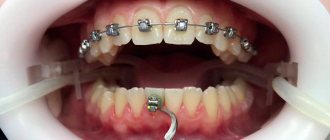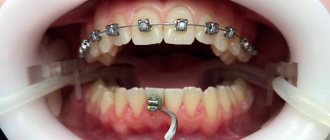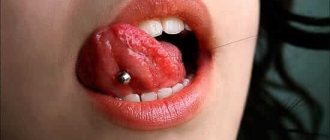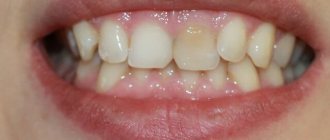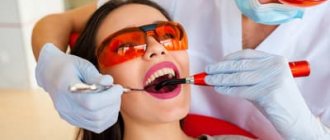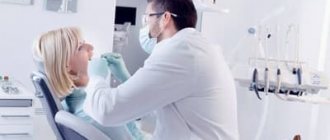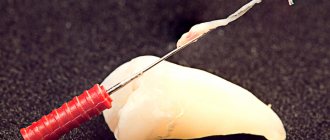Hi all! My name is Sakadynets Alexander, I have been practicing for 12 years and the number of my patients has exceeded 1000. Very often I hear repeated questions from my patients, and I understand how little quality information there is on the Internet and other sources. Sometimes the questions are logical, sometimes they are formed from incorrect information taken from various sources. Alas, myths and prejudices regarding braces still exist in society: supposedly braces contribute to the development of oral diseases, treatment with braces is painful, braces are created only for people under 18 years of age, etc. So, it’s time to collect all these questions in a bunch and try to give explanatory answers to them. I would like to note right away that not a single article can replace a live consultation with a doctor; it is for general informational purposes only.
I want braces on one jaw!
Quite a tempting option for many. But it should be understood that the answer lies already in the name “bracket-SYSTEM”, which implies the SYSTEMIC work of the orthodontic apparatus. And initially, such a decision may be completely wrong, and the amount saved will no longer be so, because all the treatment, and most importantly - time, will go down the drain.
Why?
It's all about the relationship between the upper and lower jaws: when one row of teeth moves, the other follows. And the conclusion from this is the following: braces are not installed with the aim of “straightening” some teeth. The braces system helps to change the position of the dentition in order to improve the bite! Simply put, a proper bite is when one jaw fits over the other like the gears in a watch.
What happens while wearing braces on one jaw? While the system has moved the tooth in the desired direction, another row of teeth tries to move it back. However, in some cases, the option of installing braces on one jaw is acceptable. For example, if the bite is already correct, but there is symmetry of the jaws. Or when connecting another jaw is necessary based on the patient’s clinical case.
Photo while wearing braces
Photo after wearing braces
Period of bite correction using various systems
The time it takes to use braces may depend not only on third-party factors, but also directly on the selected system model.
The difference in wearing time for different models is shown in the following table:
| Type | metal | plastic | sapphire | ceramic | vestibular | lingual |
| Period (year) | 1–1,5 | 1–2,5 | 1–3 | 1–3 | 1–3 | 1,5–2,5 |
The timing of using braces from different brands may also vary slightly.
STB
They are a lingual system that is fixed on the inside of the crowns. The period of wearing these braces is not much different from metal models and is 2 years.
In-ovation
In Ovation self-adjusting braces do not have ligatures and are more comfortable for treatment. Their wearing period is 30% less than other systems.
Incognito
The Incognito lingual system differs from the classic version in that treatment, as a rule, takes a shorter period of time . Complete correction of the dentition can be achieved after 1.5 years.
Clarity
Vestibular ceramic braces of this brand are hardly noticeable on the teeth, but teeth straightening takes a long time, taking from 1 to 3 years.
Damon
A self-regulating metal system will help correct your bite in the shortest possible time, ranging from 1 to 1.5 years.
Will braces ruin my teeth?
Let me say right away that braces do not damage your teeth. But only subject to hygiene rules and doctor’s recommendations. But here it is better to dispel several myths at once:
No. 1 Teeth under braces will definitely deteriorate
Nothing exactly happens under the braces, but the whole problem usually occurs around the braces - if the patient does not brush his teeth after every meal, then caries forms as a result.
Or if the patient has a strong tendency to form plaque (in this case, hygiene should be more careful). But if the patient could not agree on hygiene during treatment, then I usually suggest, and sometimes insist, that the orthodontic treatment be completed.
No. 2: The enamel may come off along with the braces.
When removing the braces, the doctor leaves some of the glue on the tooth, which is then easily removed with a bur, and then the teeth are polished. In this case, the enamel remains intact and unharmed.
#3: Teeth may fall out after braces.
Basically, patients understand that after proper treatment this is in no way possible. Mobility of teeth during treatment with braces - this happens, and this is normal (after all, teeth move, and this is quite logical). Retention, consisting of both removable and non-removable devices (retainers, mouth guards, plates), will help maintain the position of teeth after treatment, which will help keep the teeth in their correct position.
Duration of treatment in adults
Treatment with braces in adults is a very long process, lasting up to 3 years. This is due to some age-related characteristics.
photo: canines before and after treatment, correction period 1.5 years
Metabolic processes are slower than in children , so the trophism of the tissues of the jaw system is disrupted. This leads to decreased bone and periodontal regeneration.
In addition, in adults, skeletal growth is completely stopped, and the expansion of the jaw arch occurs with particular difficulty and only under the influence of constant strong pressure.
In addition, at this age a person has various pathologies , which also increase the wearing period:
- mental disorders;
- diseases of the immune system;
- somatic pathologies;
- diseases of the endocrine glands.
For correction, adults most often prefer to use lingual, metal or ceramic braces.
What is a good orthodontist?
Personally, I am always in favor of the patient receiving at least two third-party opinions. Orthodontic treatment must be approached very seriously, because you are committed to a relationship with the doctor for 1-2 years (or even more). Without mutual understanding, orthodontic treatment is doomed! There are several most important criteria when choosing a doctor:
- High-quality collection of information/diagnostic data
The doctor must make impressions, then carry out calculations on the models, study the OPTG image or CBCT (3-D image), and take intraoral photographs. ONLY after this can you begin treatment with the bracket system. Taking photographs is also a very important diagnostic step.
- Reviews and reputation
I won’t say obvious things here, but it’s worth paying more attention to the doctor’s actual work, rather than reviews on his personal page. By the way, negative reviews are often really unsolicited, but they can be found for literally every doctor (even the best of the best), so filter the information received. Well, no one canceled the recommendations of friends.
- Availability of diplomas/certificates
Having certificates is far from an empty phrase. This suggests that the doctor wants to develop in his field and know about new developments in the field of medicine. Do not hesitate to ask questions about where the doctor received his knowledge, practice, etc.
- Employment
Sometimes we have to work quickly, on the fly. But alas, the case is not always immediately clear. And in general, orthodontics is a science where you need to think a lot. After all, bite alignment is a kind of arcade game for the doctor. Just clarify what the doctor's plans are for you and make sure that the doctor treats your case carefully.
Orthodontists KANO
I'm already old/too old for braces
In fact, today the framework in orthodontic treatment has been completely erased. Of course, each age has its own subtleties of work for a doctor. However, the result is always the same. And one more fact - people sometimes lose their teeth not because of caries and other dental problems, but because of an incorrect bite. When the load is distributed unevenly, it ultimately leads to bone loss and tooth wear.
I will not tire of repeating that we do straight teeth not only to solve aesthetic problems. Often this will save you from early tooth loss.
Duration of treatment in children
The speed of treatment with a fixed structure in children depends directly on the timeliness of treatment. The fastest results can be achieved when installing the system for a child under 13 years of age.
At this time, the period of mixed dentition is almost over, and the jaw system slows down its growth. The duration of such treatment is usually 1 year or less. When installing, it is necessary to take into account the presence of second permanent molars. If they erupt during the treatment period, the process may drag on for at least another 8 months.
In the case when a child wore removable orthodontic structures during the period of primary and early mixed dentition, treatment with this system is reduced by almost 2 times.
The total period of wearing the structure in children is on average 8 months less than in adults. The retention period also differs significantly and is up to 2 years.
After getting braces, will I have to go on a strict diet?
Undoubtedly, there will be changes in diet, but they are absolutely not worth the fears associated with the myth that braces deprive you of gastronomic joys. You will just need to be more careful and exclude only some of the products (nuts, puffed rice, popcorn, caramel, nougat, seeds, chewing gum, etc.).
First of all, this is necessary in order not to clog the spaces between the grooves of the braces, where bacteria can accumulate and caries can develop. You should also avoid drinks with dyes, hot and cold drinks (temperature changes can cause the braces to come off).
Think for yourself, after all, braces are even a kind of motivation to start a healthy lifestyle, because it is mainly harmful foods that are excluded.
Eating while wearing braces
Is it possible to wear braces during pregnancy?
Modern braces are absolutely harmless to the body and do not cause allergies. Therefore, wearing them in itself does not in any way affect the course of pregnancy and the intrauterine development of the child. But this is subject to careful oral care! ⠀ Of course, hormonal imbalance affects the condition of the bone, but here it is necessary to conduct research from specialists and only after that decide whether treatment or continuation of treatment during pregnancy is possible. It is better to plan the installation of braces 1-2 months before pregnancy, so that all the necessary studies do not negatively affect the fetus (X-rays, CT scans, etc.). ⠀ According to experienced orthodontists, if a woman becomes pregnant, then there is no need to do anything special. It makes sense to wear braces until you finish breastfeeding, even if it is possible and will be for quite a long time. However, this will allow the bone tissue to normalize, and the woman will not miss out on the results of treatment already obtained before pregnancy. If you are pregnant or plan to become pregnant, be sure to talk to your doctor. Only a specialist will be able to correctly assess your condition and prescribe the necessary course of action!
Is it possible to treat teeth during pregnancy?
Life with braces on teeth: adaptation and care
The secret to the effectiveness of braces is the gradual movement of teeth at the level of the root system. The units move from the pathological position to the correct one, but this transition is associated with slight discomfort for the patient.
The sensations are especially unpleasant in the first days after activation: the teeth ache and even hurt. This is an adaptation period, and it lasts differently for children. Usually a week or two. Then the teeth get used to micro-movements, and the child stops feeling the braces in the mouth.
But the question of care remains open. The orthodontic design consists of many elements - with an abundance of niches, corners, and difficult-to-clean areas. Therefore, you have to devote a lot of time to caring for braces every day - 15-25 minutes twice a day. During the care process, teeth and system elements are cleaned one by one:
- orthodontic brush with V-shaped bristles;
- mono-beam brush;
- pipe cleaners;
- dental floss.
It is good to additionally use special toothpastes for patients with braces, an irrigator and a mouth rinse.
If everything is done correctly and according to the prescribed algorithms, then treatment with braces will not leave any unpleasant memories, and your teeth will acquire a straight and beautiful appearance.
Is it possible to do without retention and what is it even?
Retention is perhaps one of the most important parts of the entire treatment. Why? Teeth are harmful guys, and they will try to return to their original position, which is comfortable only for them. This is called a relapse. But neither I nor my patient want this. That’s why I really insist on retention, often even suggesting double retention.
What is retention? This is a removable or non-removable device designed to hold the dentition in the desired position. This could be a splint, a retainer (an arch behind the teeth), a night guard, or a plate.
Retainer after braces
